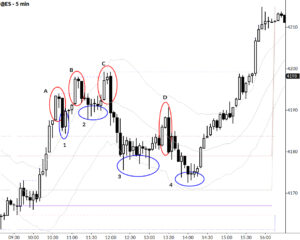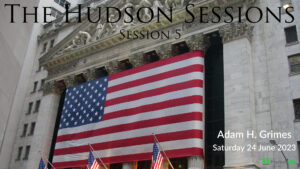Hudson Session #4 took place this past weekend. This installment is part of a series of twelve large-scale, live, interactive presentations, where I delve into a specific chapter of my debut book, “The Art and Science of Technical Analysis”. The sessions, which are receiving rave reviews, have been a delightful yet challenging endeavor for me to curate. Each session explores the ideas behind the ideas, coupled with numerous updates and lessons that I’ve personally garnered in the 10 years since I authored the book.
July’s first session focused on Trading Ranges, but we covered much more:
- The session kicked off with a discussion on randomness. I’ve long contended that price movements are often predominantly (or even entirely) random—a statement that gets some pushback, especially from aspiring traders and those who staunchly believe the market to be consistently, flawlessly predictable. (A claim as questionable as the Flat Earth theory!) This is a deep and complex topic, and the actual answers may lie more with philosophy than math. I condensed this complex subject into a concise, practical lesson aimed at resolving numerous psychological hurdles faced by traders.
- Next, we examined distributions in market data, uncovering the mathematical errors behind statements such as, “this price movement should only occur once in 10 million years, but we’ve seen it twice this year!” I discussed both daily and intraday data from long-term and short-term perspectives.
- One of the classic attacks on technical analysis is that you can’t tell the difference between a random line and a price chart. While that’s not nearly as true as the critics believe, there is a good lesson here. We spent quite a bit of time looking at some randomly generated charts I created this week, but these aren’t just any random charts. Using a specific procedure, I revealed how comparing random and real charts can impart tangible trading lessons.
- We then rolled up our sleeves and looked at more traditional technical analysis tools—single bar patterns, and I spent some time unraveling the mysteries of context. This is a critical part of chart reading, but it’s usually poorly explained, and left as a mystery for the developing trader to figure out on his own (or maybe not).
- We spent some time looking at specific elements of price action around support and resistance. I wrapped up this section with a do-it-yourself exercise designed to enhance your pattern recognition skills. Though the exercise may take a few hours, it’s time well spent for any technical trader.
- To cap off the session, I provided some clear templates for trading in ranges, including where to enter, where to exit, and where to place stops. The theory ultimately distills to practical application; traders must have a robust plan to tackle these complex areas of price action.
This was a fantastic session. You can catch it on replay here.
Register for session 5 using this link. In this session, we’ll look at ends of trends, breakouts, failures, and much more. I’ll see you there in a few weeks!



